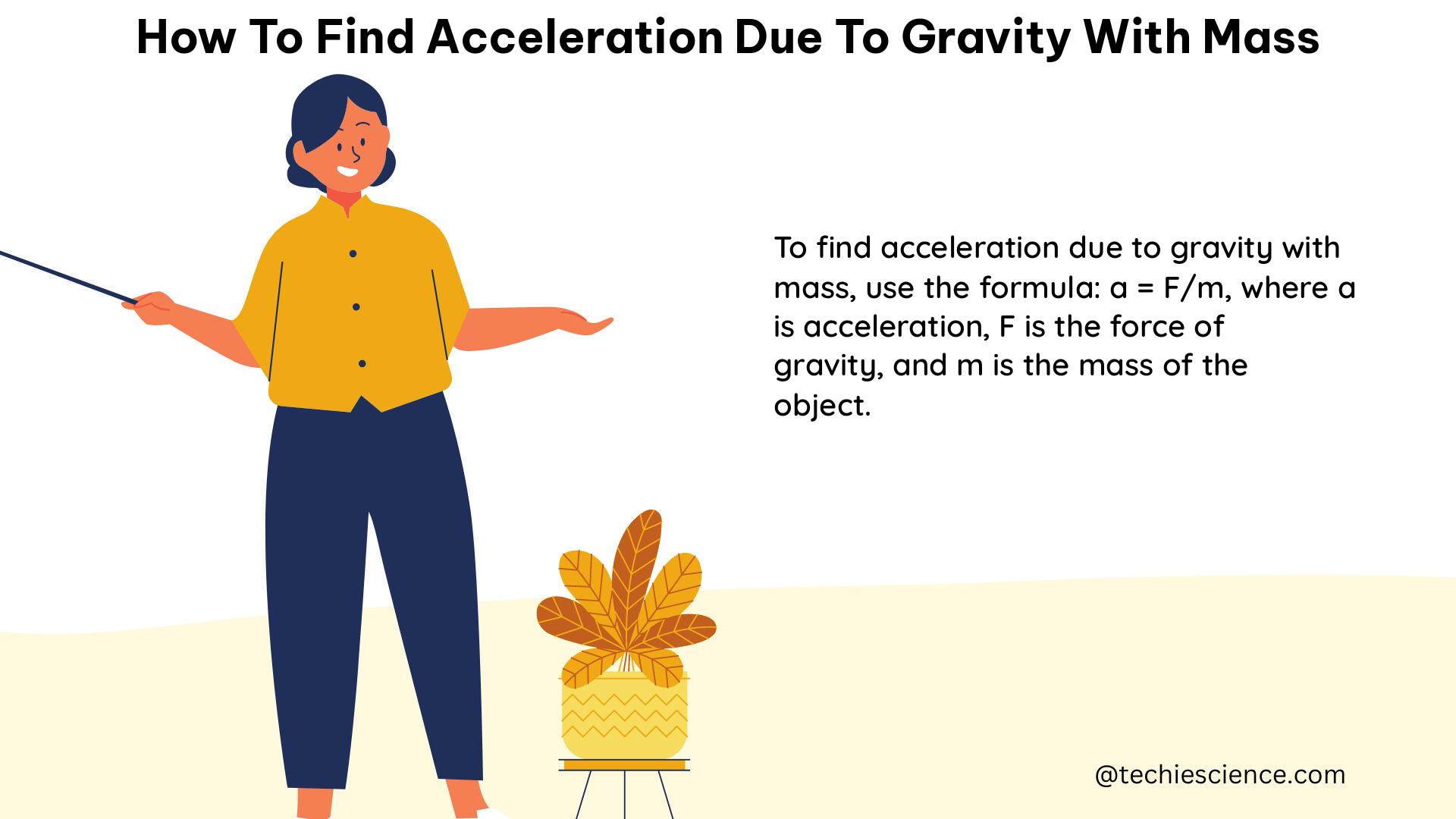The acceleration due to gravity, denoted as ‘g’, is a fundamental physical quantity that describes the rate of change in the velocity of an object due to the Earth’s gravitational pull. Determining the acceleration due to gravity with mass is crucial in various fields, such as physics, engineering, and astronomy. This comprehensive guide will delve into the theoretical foundations, formulas, and practical applications of finding the acceleration due to gravity with mass.
Understanding the Gravitational Constant and Newton’s Law of Universal Gravitation
The acceleration due to gravity is directly related to the gravitational constant, denoted as ‘G’, which is a universal physical constant that describes the strength of the gravitational force between two objects. The value of the gravitational constant is approximately 6.673 × 10^-11 N⋅m^2/kg^2.
According to Newton’s Law of Universal Gravitation, the gravitational force between two objects is proportional to the product of their masses and inversely proportional to the square of the distance between them. This relationship is expressed mathematically as:
F = G * (M1 * M2) / r^2
Where:
– F is the gravitational force between the two objects
– G is the gravitational constant
– M1 and M2 are the masses of the two objects
– r is the distance between the centers of the two objects
The Formula for Acceleration Due to Gravity with Mass

The acceleration due to gravity, ‘g’, can be calculated using the following formula:
g = G * M / r^2
Where:
– g is the acceleration due to gravity
– G is the gravitational constant
– M is the mass of the object
– r is the distance from the center of the object to the point where the acceleration is being measured
This formula is derived directly from Newton’s Law of Universal Gravitation and allows us to determine the acceleration due to gravity at any given distance from the center of an object with a known mass.
Practical Examples and Applications
Example 1: Calculating the Acceleration Due to Gravity on the Earth’s Surface
To find the acceleration due to gravity on the Earth’s surface, we can use the following values:
– Gravitational constant, G = 6.673 × 10^-11 N⋅m^2/kg^2
– Mass of the Earth, M = 5.979 × 10^24 kg
– Radius of the Earth, r = 6.376 × 10^6 m
Plugging these values into the formula, we get:
g = G * M / r^2
g = (6.673 × 10^-11 N⋅m^2/kg^2) * (5.979 × 10^24 kg) / (6.376 × 10^6 m)^2
g = 9.8 m/s^2
This is the standard value for the acceleration due to gravity on the Earth’s surface, which is approximately 9.8 m/s^2.
Example 2: Calculating the Acceleration Due to Gravity at a Specific Height Above the Earth’s Surface
Let’s say we want to find the acceleration due to gravity at a height of 2000 km above the Earth’s surface. In this case, the distance from the center of the Earth to the point of measurement is the sum of the Earth’s radius and the height above the surface:
r = 6.376 × 10^6 m + 2000 × 10^3 m = 8.376 × 10^6 m
Plugging this value into the formula, we get:
g = G * M / r^2
g = (6.673 × 10^-11 N⋅m^2/kg^2) * (5.979 × 10^24 kg) / (8.376 × 10^6 m)^2
g = 9.5 m/s^2
This shows that the acceleration due to gravity decreases as the distance from the Earth’s center increases, as predicted by the inverse square relationship in the formula.
Factors Affecting the Acceleration Due to Gravity
The acceleration due to gravity can be influenced by several factors, including:
- Altitude: As the distance from the Earth’s surface increases, the acceleration due to gravity decreases due to the inverse square relationship.
- Latitude: The acceleration due to gravity is slightly higher at the poles than at the equator due to the Earth’s oblate spheroid shape.
- Density Variations: Variations in the Earth’s density, such as the presence of mountains or underground structures, can affect the local acceleration due to gravity.
- Tidal Effects: The gravitational pull of the Moon and Sun can cause small variations in the acceleration due to gravity, known as tidal effects.
Limitations and Considerations
It’s important to note that the formula for acceleration due to gravity with mass assumes a point-like object and a uniform gravitational field. In reality, the Earth’s gravitational field is not perfectly uniform, and the mass distribution within the Earth is not perfectly spherical. These factors can introduce small deviations from the theoretical values calculated using the formula.
Additionally, the formula assumes that the object’s mass is much smaller than the mass of the Earth, which is generally a valid assumption for most practical applications. However, in situations where the object’s mass is significant compared to the Earth’s mass, the formula may need to be modified to account for the mutual gravitational attraction between the two objects.
Conclusion
Determining the acceleration due to gravity with mass is a fundamental concept in physics and has numerous practical applications. By understanding the underlying principles, formulas, and factors that influence the acceleration due to gravity, you can accurately calculate this important physical quantity in a variety of scenarios. This comprehensive guide has provided you with the necessary tools and knowledge to confidently tackle problems related to the acceleration due to gravity with mass.
References
- https://www.intmath.com/blog/mathematics/calculating-acceleration-due-to-gravity-on-a-plane-12517
- http://fofweb.com/Electronic_Images/Onfiles/SEOF4-57.pdf
- https://study.com/academy/lesson/calculating-acceleration-due-to-gravity-formula-lesson-quiz.html
- https://www.physics.smu.edu/~ryszard/1313fa97/1313-Acceler_.PDF

The lambdageeks.com Core SME Team is a group of experienced subject matter experts from diverse scientific and technical fields including Physics, Chemistry, Technology,Electronics & Electrical Engineering, Automotive, Mechanical Engineering. Our team collaborates to create high-quality, well-researched articles on a wide range of science and technology topics for the lambdageeks.com website.
All Our Senior SME are having more than 7 Years of experience in the respective fields . They are either Working Industry Professionals or assocaited With different Universities. Refer Our Authors Page to get to know About our Core SMEs.